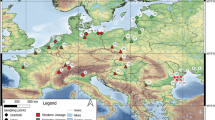Abstract
Among the Cladocera, the occurrence of interspecific hybrids in nature has been reported frequently but rarely adequately documented. During the course of a survey of the genetic variation and population structure of several species ofSimocephalus in ponds in southern Ontario, Canada, readily distinguishable congeners often co-occurred in a pond. Occasionally, clones were recovered that were intermediate in phenotype (as determined from both morphological and electrophoretic analyses) between two species. Two different hybrid clones have been examined in detail to determine the parentals involved in the crosses. Evidence from field and laboratory studies is presented to document the hybrid nature of these clones. Factors favouring formation and long-term survival of hybrids in littoral zone and pelagic species are discussed.
Similar content being viewed by others
References
Agar, W. E., 1920. The genetics of aDaphnia hybrid during parthenogenesis. J. Genet. 10: 303–330.
Ayala, F. J., 1975. Genetic differentiation during the speciation process. In T. Dobzhansky, M. K. Hecht & W. C. Steere (eds), Evolutionary Biology. Plenum Press, NY, Vol. 8: 1–78.
Berg, K., 1931. Studies on the genusDaphnia O. F. Müller with especial reference to the mode of reproduction. Vidensk. Medd. dansk naturh. Foren. 92: 1–222.
Birge, A. E., 1918. The water fleas (Cladocera). In H. B. Ward & G. C. Whipple (eds), Fresh-water Biology. John Wiley & Sons, NY: 676–740.
Brooks, J. L., 1957. The systematics of North AmericanDaphnia. Mem. Conn. Acad. Arts Sci. 13: 1–180.
Einsle, U., 1966. Einige Beobachtungen und Hypothesen zur Taxonomie der GattungDaphnia. Schr. Reihe. V.G. Bodensee 84: 1–17.
Einsle, U., 1978. Qualitative und quantitative Änderungen im Crustaceenplankton des Bodensees-Obersee. Arch. Hydrobiol. 82: 300–315.
Flössner, D., 1972. Kiemen- und Blattfüsser, Branchiopoda, Fischläuse, Branchiura. Tierwelt Deutschlands 60: 1–501.
Frey, D. G., 1982. Contrasting strategies of gamogenesis in northern and southern populations of Cladocera. Ecology 63: 223–241.
Gerritsen, J., 1980. Sex and parthenogenesis in sparse populations. Am. Nat. 115: 718–742.
Goulden, C. E., 1968. The systematics and evolution of the Moinidae. Trans. Am. Phil. Soc., n.s. 58: 1–101.
Hann, B. J., 1982. Two new species ofEurycercus (Bullatifrons) from eastern North America (Chydoridae, Cladocera). Int. Revue ges. Hydrobiol. 67: 585–610.
Hann, B. J. & P. D. N. Hebert, 1982. Re-interpretation of genetic variation inSimocephalus (Cladocera, Daphniidae). Genetics 102: 101–107.
Hann, B. J. & P. D. N. Hebert, 1986. Genetic variation and population differentiation in species ofSimocephalus (Cladocera, Daphniidae). Can. J. Zool. 64: 000–000.
Hebert, P. D. N., 1985. Interspecific hybridization between cyclic parthenogens. Evolution 39: 216–220.
Kubersky, E. S., 1977. Worldwide distribution and ecology ofAlonopsis (Cladocera, Chydoridae) with a description ofAlonopsis americana sp. nov. Int. Revue ges. Hydrobiol. 62: 649–685.
Lieder, U., 1956. Introgressive Hybridization als Evolutionsfaktor bei den GattungenBosmina undDaphnia (Crustacea, Cladocera). Naturwissenschaften 43: 207.
Lieder, U., 1983a. A revision of the genusBosmina Baird, 1845 (Crustacea, Cladocera). Int. Revue ges. Hydrobiol. 68: 121–139.
Lieder, U., 1983b. Introgression as a factor in the evolution of polytypical plankton Cladocera. Int. Revue ges. Hydrobiol. 68: 269–284.
Nei, M., 1978. Estimation of average heterozygosity and genetic distance from a small number of individuals. Genetics 89: 583–590.
Selander, R. K., 1976. Genic variation in natural populations. In F. J. Ayala (ed.), Molecular Evolution. Sinauer Associates, Inc., Publishers, Sunderland, MA: 21–45.
Shan, R. K., 1974. Reproduction in laboratory stocks ofPleuroxus (Chydoridae, Cladocera) under the influence of photoperiod and light intensity. Int. Revue ges. Hydrobiol. 59: 643–666.
Shan, R. K. & D. G. Frey, 1968. Induced interbreeding between two stocks of a chydorid Cladoceran. BioScience 18: 203–205.
Shan, R. K. & D. G. Frey, 1983.Pleuroxus denticulatus andP. procurvus (Cladocera, Chydoridae) in North America: distribution, experimental hybridization, and the possibility of natural hybridization. Can. J. Zool. 61: 1605–1617.
Swofford, D. L. & R. B. Selander, 1981. BIOSYS-1: a FORTRAN program for the comprehensive analysis of electrophoretic data in population genetics and systematics. J. Heredity 72: 281–283.
Wolf, H. G., 1986. this volume.
Woltereck, R., 1911. Beitrag zur Analyse der ‘Vererbung erworbener Eigenschaften’: Transmutation und Präinduktion beiDaphnia. Verh. Dtsch. Zool. Ges. 1911: 141–172.
Author information
Authors and Affiliations
Rights and permissions
About this article
Cite this article
Hann, B.J. Naturally occurring interspecific hybridization inSimocephalus (Cladocera, Daphniidae): its potential significance. Hydrobiologia 145, 219–224 (1987). https://doi.org/10.1007/BF02530283
Issue Date:
DOI: https://doi.org/10.1007/BF02530283




